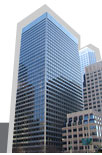Energy
& Atmosphere
According
to the U.S. Department of Energy, buildings use 39% of the
energy and 74% of the electricity produced in the United States.
The Energy & Atmosphere category promotes strategies that
buildings use to conserve energy. Reducing energy consumption
improves the energy performance of buildings, reduces operating
costs and pollution and enhances occupant comfort. These strategies
include Retro-Commissioning; energy use monitoring; efficient
design and construction; efficient appliances; systems and
lighting; the use of renewable and clean sources of energy,
generated on-site or off-site; and many other innovative approaches.
- 425
Market Street participates in PG&E's Retro-Commissioning
program. Retro-commissioning is a systematic and documented
process of identifying which of the building's systems,
including mechanical/HVAC, lighting, plumbing, and standby
power, are not performing to their intended level and making
necessary repairs or improvements to save energy and cost.
In 2014, Taylor Engineering performed a Retro-Commissioning
audit of the existing building systems and provided a draft audit report. Once the final report is received and recommendations provided, the building will evaluate each measure for implementation and likely low- and no cost measures will be immediately implemented.
- Cushman
Wakefield has been a United States EPA Energy Star Partner
since 1999 and has been participating with the EPA on various
levels. The EPA Energy Star program provides a standardized
methodology that is recognized and accepted throughout the
commercial real estate industry. 425 Market Street benchmarks
its electricity, gas and water consumption by using the
Energy Star web-based tool called “Portfolio Manager”. 425
Market St. first earned the Energy Star rating in 2006 and
in 2013 achieved an Energy Star rating of 88 out of a maximum
point scale of 100.
- 425
Market St. has a building operations plan that identifies
what needs of the building and procedures to meet those
needs. Through ongoing testing, maintenance, and monitoring
of these systems, the building is able to meet these requirements
at the most efficient level.
|

